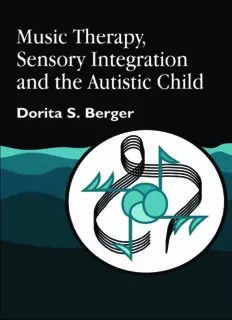
Music Therapy, Sensory Integration and the Autistic Child PDF
Preview Music Therapy, Sensory Integration and the Autistic Child
Music Therapy, Sensory Integration and the Autistic Child of related interest Music Therapy and Group Work Sound Company Edited by Alison Davies and Eleanor Richards ISBN 1 84310 036 3 Music Therapy Research and Practice in Medicine From Out of the Silence David Aldridge ISBN 1 85302 296 9 Clinical Application of Music Therapy in Developmental Disability, Paediatrics and Neurology Edited by Tony Wigram and Jos de Backer ISBN 1 85302 734 0 Music Therapy – Intimate Notes Mercédès Pavlicevic ISBN 1 85302 692 1 Art Therapy with Children on the Autistic Spectrum Beyond Words Kathy Evans and Janek Dubowski ISBN 1 85302 825 8 Art Therapy and AD/HD Diagnostic and Therapeutic Approaches Diane Stein Safran ISBN 1 84310 709 0 Autism – The Search for Coherence Edited by John Richer and Sheila Coates ISBN 1 85302 888 6 Bright Splinters of the Mind A Personal Story of Research with Autistic Savants Beate Hermelin ISBN 1 85302 932 7 Music Therapy, Sensory Integration and the Autistic Child Dorita S. Berger Jessica Kingsley Publishers London and New York All rights reserved. No part of this publication may be reproduced in any material form (including photocopying or storing it in any medium by electronic means and whether or not transiently or incidentally to some other use of this publication) without the written permission of the copyright owner except in accordance with the provisions of the Copyright, Designs and Patents Act 1988 or under the terms of a licence issued by the Copyright Licensing Agency Ltd, 90 Tottenham Court Road, London, England W1P 9HE. Applications for the copyright owner’s written permission to reproduce any part of this publication should be addressed to the publisher. Warning: The doing of an unauthorised act in relation to a copyright work may result in both a civil claim for damages and criminal prosecution. The right of Dorita S. Berger to be identified as author of this work has been asserted by her in accordance with the Copyright, Designs and Patents Act 1988. First published in the United Kingdom in 2002 by Jessica Kingsley Publishers Ltd 116 Pentonville Road, London N1 9JB, England and 29 West 35th Street, 10th fl. New York, NY 10001-2299, USA © Copyright 2002 Dorita S. Berger Foreword © copyright Donna Williams Second impression 2003 www.jkp.com Library of Congress Cataloging in Publication Data A CIP catalog record for this book is available from the Library of Congress British Library Cataloguing in Publication Data A CIP catalogue record for this book is available from the British Library ISBN 1 84310 700 7 Printed and Bound in Great Britain by Athenaeum Press, Gateshead, Tyne and Wear In memory of my parents, Charlotte and Leon Schneck – two special people who taught me to inquire Contents Foreword 11 Preface 13 1 Introduction: Who Defines “Appropriate”? 17 What’s in a “label”? What determines “right” and “wrong” responses? The brain does not know that it does not know 2 Aspects of Autism 26 General characteristics of autism Autistic “aloneness” Desire for sameness and structure Learning to translate autistic behavior References Recommended reading 3 Aspects of Sensory Integration 35 Our emotional brains The journey begins From RAS to Ring Filing into memory Primary, secondary and tertiary memory Opening the gates to learning – the neo-cortex Touring the neo-cortex landscape Sensory interpretation is individual References Recommended reading 4 Functional Adaptation Defined 49 Four basic human survival needs Three basic levels of physiologic adaptation Music Therapy for conditioned adaptive accommodation References 5 Understanding Basic Sensory Systems 61 The vestibular system The proprioceptive system The tactile system Visual and auditory sensory systems The visual system References 6 Are You Listening? 78 Part One: About Hearing and Listening Audition – the act of hearing It’s all in our heads The coding of sound Auditory scanning Two ears, two sounds? Sound coding tango Hearing for patterns “Hearing” and “Listening” Dimensional hearing Auditory integration Recommended reading 7 Are You Listening? 91 Part Two: Dimensional Hearing and Erroneous Assumptions About Jason Some common erroneous assumptions Auditory tracking Auditory discrimination and memory Auditory figure-ground Auditory focus Auditory depth perception and auditory sound location Auditory integration reviewed Jason revisited Integration of auditory and visual processes Auditory-motor coordination References Recommended reading 8 Elements of Music for Sensory Adaptation 112 Rhythm Components of rhythm Melody Harmony Timbre Dynamics Form Review References Recommended reading 9 Music Therapy in the Realm of Sensory Integration 130 Integrating physiologic knowledge with therapy approaches Evaluating physiology for adaptive goals Aspects of music therapy treatment Instruments for sensory integration goals Instruction as therapy Summary Recommended reading 10 Formulating Music Therapy Treatment for Sensory Adaptation Goals 152 Rhythm internalization Adaptive responses to environment of auditory and visual stimuli Auditory integration and discrimination Auditory-physical integration, motor planning, vestibular actions, body coordination in space Auditory-visual integration: see-hear sound Auditory-mental-physical coordination Pacing of body movements, breath Sequencing Limit-setting and behavioral redirection Creativity, self-initiative, task organization Speech and language Music therapy support for cognitive and allied therapies goals How much therapy is enough? 11 Conclusion 166 We are emotional animals Mind and emotion Music in human adaptation A word about group therapy Finally… Recommended reading APPENDIX A THE ROLE OF MUSIC IN PHYSIOLOGIC ACCOMMODATION, DANIEL J. SCHNECK AND DORITA S. BERGER 176 APPENDIX B SAMPLE ASSESSMENTS AND PROGRESS REPORTS 193 BIBLIOGRAPHY 237 INDEX 245
Description: